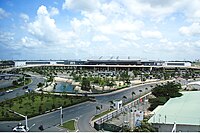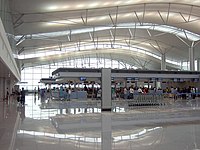Tan Son Nhat Airport
| Tan Son Nhat Airport | |
|---|---|

|
|
| Characteristics | |
| ICAO code | VVTS |
| IATA code | SGN |
| Coordinates | |
| Height above MSL | 10 m (33 ft ) |
| Transport links | |
| Distance from the city center | 8 km north of Ho Chi Minh City |
| Basic data | |
| Terminals | 2 (one international and one national) |
| Passengers | 41.1 million (2019) |
| Air freight | 697.848 |
| Flight movements |
111,314 |
| Runways | |
| 07R / 25L | 3800 m × 45 m concrete |
| 07L / 25R | 3048 m × 45 m concrete |
The international airport Tân Sơn Nhất ( vietn . : Cảng hàng không quốc tế Tân Sơn Nhất , English Tan Son Nhat International Airport ) is Vietnam 's largest international airport. It is located in Ho Chi Minh City (Thành phố Hồ Chí Minh) in southern Vietnam. Its IATA code SGN was derived from the former name Saigon . In 2010, around 18 million passengers were handled at the airport. That was around 250 percent more than in 2005. In 2016 there were already 32.5 million and in 2019 41.1 million passengers.
history
In 1920 the French colonial authorities decided to build a military airfield with an unpaved runway north of Saigon near the settlement of Tân Sơn Nhất (from Chinese新 山 一, lit. "New Mountain One") or Tân Sơn Nhứt north of Saigon. One of the first operations performed from Tan Son Nhat involved taking more than 2,000 photos during aerial mapping flights by the end of 1920. In the same year, the French completed the construction of 34 emergency landing sites across Indochina , which was a prerequisite for safe flight operations. On April 19, 1921, the first civil flight to Hanoi took place. In 1930 the first passenger terminal was built. In 1934 the runway was paved and a full-fledged passenger terminal was opened. Due to the global economic crisis, an expansion originally planned for the 1930s could not be carried out. On 21 December 1933, the first scheduled occurred direct flight of Air France to Paris. Since a night flight was not yet possible at that time, the travel time for this flight, which was carried out in stages, was one week.
The US foreign aid in mid-1956 built a runway 2190 meters long; this became the international airport of South Vietnam . During the Vietnam War , Tan Son Nhut Air Base was an important approach point for both the United States and the South Vietnamese Air Force (VNAF) . Before the US withdrawal in 1975, Tan Son Nhat Airport was one of the most frequented military airfields in the world. In the final phase of the war, the airport was bombed on April 28 and 29, 1975.
On December 9, 2004, United Airlines became the first US airline to fly to Vietnam after the conquest of Saigon. A Boeing 747-400 landed in Ho Chi Minh City as an extension of their previous route San Francisco - Hong Kong .
The new international terminal
The new international terminal has been built by a consortium of four Japanese contractors (KTOM) since 2005. The invested capital for this terminal is approximately $ 260 million, supported by the State Development Assistance of Japan (ODA). This four-story terminal, which opened in August 2008, has an area of 100,000 square meters and is equipped with eight passenger boarding bridges and modern facilities. The capacity is between 8 and 10 million international passengers per year; the older terminal now only serves domestic flights.
Airlines
The airport serves Jetstar Pacific as its operational base. It is also a hub for Vietnam Airlines and VietJet Air .
The airport is served by the following airlines, among others:
- Aeroflot
- Air Astana
- Air China
- Air France
- AirAsia
- All Nippon Airways operated by Air Japan
- Asiana Airlines
- Cambodia Angkor Air
- Cathay Pacific
- Cebu Pacific
- China Airlines
- China Eastern
- China Southern Airlines
- Edelweiss Air
- Emirates
- Eastar Jet
- Etihad Airways
- EVA Air
- Finnair
- Hong Kong Airlines
- Japan Airlines
- Jetstar Asia Airways
- Jetstar Pacific
- Korean Air
- Lao Airlines
- Lion Air
- Malaysia Airlines
- Mandarin Airlines
- Nok Air
- Novair
- Philippine Airlines
- Royal Brunei
- Qatar Airways
- Sichuan Airlines
- Singapore Airlines
- Thai AirAsia
- Thai Airways
- Tigerair
- Turkish Airlines
- United Airlines
- Vietnam Airlines
- Vietnam Airlines operated by VASCO
- VietJet Air
- Wind Rose Aviation
aims
foreign countries
- Abu Dhabi
- Almaty
- Bangkok Suvarnabhumi
- Bangkok-Don Mueang
- Bandar Seri Begawan
- Cheng you
- Busan
- Doha
- Dubai
- Fukuoka
- Frankfurt am Main
- Fuzhou
- Guangzhou
- Helsinki (seasonal)
- Hong Kong
- Istanbul
- Jakarta
- Jeju
- Johor Bahru
- Kaohsiung
- Kiev
- Kuala Lumpur
- London Heathrow
- Manila
- Melbourne
- Moscow Sheremetyevo
- Moscow Domodedovo
- Nagoya
- Nanning
- New Delhi
- Osaka
- Pakse
- Paris-Charles de Gaulle
- Beijing
- Penang
- Phnom Penh
- Yangon (Yangon)
- Seoul Incheon
- Shanghai Pudong
- Siem Reap
- Singapore
- Stockholm (seasonal)
- Sydney
- Taichung
- Taipei
- Tokyo Haneda
- Tokyo Narita
- Vientiane
- Wuhan
Air freight connections
- Lufthansa Cargo : Frankfurt
- Air France Cargo: Paris-Charles de Gaulle
- Air Hong Kong : Hong Kong , Penang
- Asiana Cargo : Seoul-Incheon
- Cardig Air : Jakarta
- Cargolux : Luxembourg
- China Airlines Cargo: Taipei-Taoyuan , Luxembourg , Singapore , Bangkok-Suvarnabhumi
- FedEx Express: Guangzhou , Hà Nội , Jakarta
- Hong Kong Airlines Cargo: Hong Kong
- Korean Air Cargo: Jakarta , Seoul-Incheon
- MASkargo: Kuala Lumpur
- Qantas Freight : Shanghai-Pudong , Sydney
- Raya Airways : Bangkok-Suvarnabhumi
- Tri-MG Intra Asia Airlines : Bangkok-Suvarnabhumi , Phnom Penh
New major airport under construction
The capacity of the completely renovated airport close to the city has been exhausted for some time, and a new major airport has long been planned for the fast-growing international air traffic. A master plan was presented in April 2006; the site is located in Long Thanh County, Dong Nai Province, around 50 kilometers east of Ho Chi Minh City. The Long Thanh International Airport should have (4000 × 60 meters) in the final stage in an area of 50 square kilometers four runways.
The project will be gradually expanded from an initial 20 million passengers a year to 100 million. The freight capacity is also expected to reach 5 million tons a year; This would make Long Thanh International Airport one of the most important airports in the entire Southeast Asian region.
After many delays, construction is scheduled to start in 2020.
Incidents
- On 22 June 1967, a collided Lockheed L-1049H Super Constellation of Airlift International ( air vehicle registration N6936C ) on the flight from Manila airport Saigon-Tan Son Nhat a McDonnell RF-4C Phantom II of the US Air Force (Mark 65- 0861 ). The cargo plane was approaching when it was rammed by the military aircraft and crashed 6.5 kilometers north of the destination airport. All seven occupants of the civil plane, four crew members and three passengers were killed. The two crew members of the Phantom saved themselves with the ejection seat.
- On April 4, 1975, during the US evacuation operation Babylift, the first transport with a Lockheed C-5 Galaxy ended in disaster. Three out of eight locking bolts on the rear hatch failed 40 miles from Saigon. An explosive decompression of the aircraft followed. Due to the damage, the aircraft was hardly controllable; the crew had to return to Tan Son Nhut with the defective aircraft. 155 people died in the crash landing in a rice field three kilometers from the airport. Most of the survivors sat on the upper deck of the Galaxy, while the passengers on the lower deck almost all perished.
Web links
Individual evidence
- ↑ a b tsnairport.hochiminhcity.gov.vn
- ↑ Sân bay Tân Sơn Nhứt được hình thành như thế nào?
- ↑ James Clark: Long Thanh International Airport. A comprehensive guide to the future new airport of Ho Chi Minh City . In: livinginasia.co . July 11, 2019. Retrieved April 17, 2020.
- ↑ Joe Baugher: USAF serials , accessed December 22, 2019.
- ↑ accident report L-1049H N6936C , Aviation Safety Network (English), accessed on 22 December of 2019.
- ^ Accident report C-5A Galaxy 68-0218 , Aviation Safety Network (English), accessed on June 25, 2018.




